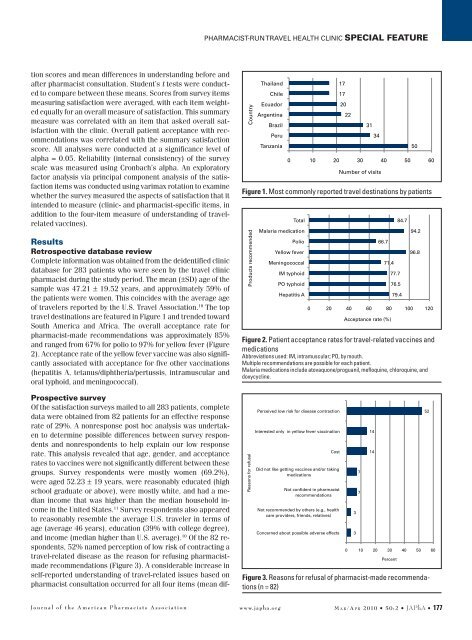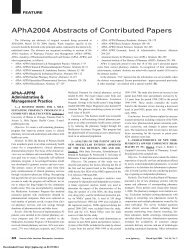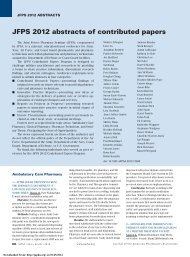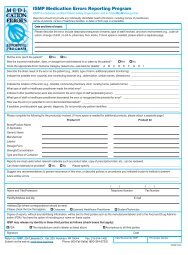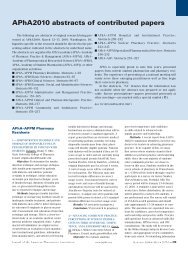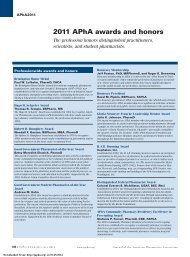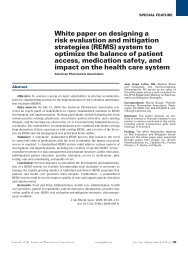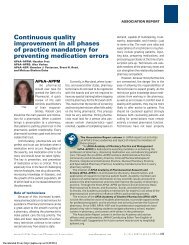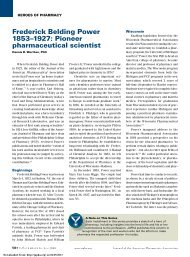Measuring outcomes of a pharmacist-run travel health clinic located ...
Measuring outcomes of a pharmacist-run travel health clinic located ...
Measuring outcomes of a pharmacist-run travel health clinic located ...
You also want an ePaper? Increase the reach of your titles
YUMPU automatically turns print PDFs into web optimized ePapers that Google loves.
tion scores and mean differences in understanding before and<br />
after <strong>pharmacist</strong> consultation. Student’s t tests were conducted<br />
to compare between these means. Scores from survey items<br />
measuring satisfaction were averaged, with each item weighted<br />
equally for an overall measure <strong>of</strong> satisfaction. This summary<br />
measure was correlated with an item that asked overall satisfaction<br />
with the <strong>clinic</strong>. Overall patient acceptance with recommendations<br />
was correlated with the summary satisfaction<br />
score. All analyses were conducted at a significance level <strong>of</strong><br />
alpha = 0.05. Reliability (internal consistency) <strong>of</strong> the survey<br />
scale was measured using Cronbach’s alpha. An exploratory<br />
factor analysis via principal component analysis <strong>of</strong> the satisfaction<br />
items was conducted using varimax rotation to examine<br />
whether the survey measured the aspects <strong>of</strong> satisfaction that it<br />
intended to measure (<strong>clinic</strong>- and <strong>pharmacist</strong>-specific items, in<br />
addition to the four-item measure <strong>of</strong> understanding <strong>of</strong> <strong>travel</strong>related<br />
vaccines).<br />
Results<br />
Retrospective database review<br />
Complete information was obtained from the deidentified <strong>clinic</strong><br />
database for 283 patients who were seen by the <strong>travel</strong> <strong>clinic</strong><br />
<strong>pharmacist</strong> during the study period. The mean (±SD) age <strong>of</strong> the<br />
sample was 47.21 ± 19.52 years, and approximately 59% <strong>of</strong><br />
the patients were women. This coincides with the average age<br />
<strong>of</strong> <strong>travel</strong>ers reported by the U.S. Travel Association. 10 The top<br />
<strong>travel</strong> destinations are featured in Figure 1 and trended toward<br />
South America and Africa. The overall acceptance rate for<br />
<strong>pharmacist</strong>-made recommendations was approximately 85%<br />
and ranged from 67% for polio to 97% for yellow fever (Figure<br />
2). Acceptance rate <strong>of</strong> the yellow fever vaccine was also significantly<br />
associated with acceptance for five other vaccinations<br />
(hepatitis A, tetanus/diphtheria/pertussis, intramuscular and<br />
oral typhoid, and meningococcal).<br />
Prospective survey<br />
Of the satisfaction surveys mailed to all 283 patients, complete<br />
data were obtained from 82 patients for an effective response<br />
rate <strong>of</strong> 29%. A nonresponse post hoc analysis was undertaken<br />
to determine possible differences between survey respondents<br />
and nonrespondents to help explain our low response<br />
rate. This analysis revealed that age, gender, and acceptance<br />
rates to vaccines were not significantly different between these<br />
groups. Survey respondents were mostly women (69.2%),<br />
were aged 52.23 ± 19 years, were reasonably educated (high<br />
school graduate or above), were mostly white, and had a median<br />
income that was higher than the median household income<br />
in the United States. 11 Survey respondents also appeared<br />
to reasonably resemble the average U.S. <strong>travel</strong>er in terms <strong>of</strong><br />
age (average 46 years), education (39% with college degree),<br />
and income (median higher than U.S. average). 10 Of the 82 respondents,<br />
52% named perception <strong>of</strong> low risk <strong>of</strong> contracting a<br />
<strong>travel</strong>-related disease as the reason for refusing <strong>pharmacist</strong>made<br />
recommendations (Figure 3). A considerable increase in<br />
self-reported understanding <strong>of</strong> <strong>travel</strong>-related issues based on<br />
<strong>pharmacist</strong> consultation occurred for all four items (mean dif-<br />
PHARMACIST-RUn TRAvEL HEALTH CLInIC SPECIAL FEATURE<br />
J o u r n a l o f t h e A m e r i c a n P h a r m a c i s t s A s s o c i a t i o n www.japha.org M a r/apr 2010 • 50:2 • JAPhA • 177<br />
Country<br />
Reasons for refusal<br />
Thailand<br />
Chile<br />
Ecuador<br />
Argentina<br />
Brazil<br />
Peru<br />
Tanzania<br />
Perceived low risk for disease contraction<br />
Interested only in yellow fever vaccination<br />
Cost<br />
Did not like getting vaccines and/or taking<br />
medications<br />
Not confident in <strong>pharmacist</strong><br />
recommendations<br />
Not recommended by others (e.g., <strong>health</strong><br />
care providers, friends, relatives)<br />
Concerned about possible adverse effects<br />
17<br />
17<br />
20<br />
22<br />
0 10 20 30 40 50 60<br />
3<br />
3<br />
7<br />
7<br />
31<br />
14<br />
14<br />
34<br />
Number <strong>of</strong> visits<br />
Figure 1. Most commonly reported <strong>travel</strong> destinations by patients<br />
Products recommended<br />
Total<br />
Malaria medication<br />
Polio<br />
Yellow fever<br />
Meningococcal<br />
IM typhoid<br />
PO typhoid<br />
Hepatitis A<br />
66.7<br />
71.4<br />
77.7<br />
76.5<br />
52<br />
0 10 20 30 40 50 60<br />
Percent<br />
79.4<br />
84.7<br />
50<br />
94.2<br />
96.8<br />
0 20 40 60 80 100 120<br />
Acceptance rate (%)<br />
Figure 2. Patient acceptance rates for <strong>travel</strong>-related vaccines and<br />
medications<br />
Abbreviations used: IM, intramuscular; PO, by mouth.<br />
Multiple recommendations are possible for each patient.<br />
Malaria medications include atovaquone/proguanil, mefloquine, chloroquine, and<br />
doxycycline.<br />
Figure 3. Reasons for refusal <strong>of</strong> <strong>pharmacist</strong>-made recommendations<br />
(n = 82)<br />
177 3/1/10 12:49 PM


